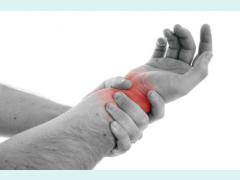
Carpal tunnel syndrome
Carpal tunnel syndrome (CTS), or median neuropathy at the wrist, is a medical condition in which the median nerve is compressed at the wrist, leading to paresthesias, numbness and muscle weakness in the hand. The diagnosis of CTS is often misapplied to patients who have activity-related arm pain.
Most cases of CTS are idiopathic (without known cause), genetic factors determine most of the risk, and the role of arm use and other environmental factors is disputed.
Night symptoms and waking at night--the hallmark of this illness--can be managed effectively with night-time wrist splinting in most patients. The role of medications, including corticosteroid injection into the carpal canal, is unclear. Surgery to cut the transverse carpal ligament is effective at relieving symptoms and preventing ongoing nerve damage, but established nerve dysfunction in the form of static (constant) numbness, atrophy, or weakness are usually permanent and do not respond predictably to surgery.
Clinical assessment by history taking and physical examination can support a diagnosis of CTS.
Phalen's maneuver is performed by flexing the wrist gently as far as possible, then holding this position and awaiting symptoms. A positive test is one that results in numbness in the median nerve distribution when holding the wrist in acute flexion position within 60 seconds. The quicker the numbness starts, the more advanced the condition.
Tinel's sign, a classic, though less specific test, is a way to detect irritated nerves. Tinel's is performed by lightly tapping the area over the nerve to elicit a sensation of tingling or "pins and needles" in the nerve distribution.